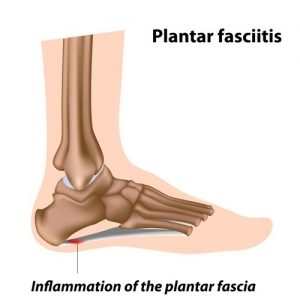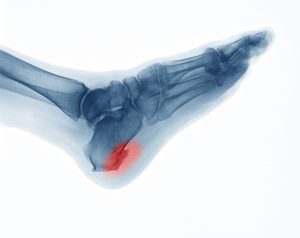
Heel Pain – Plantar Fasciitis
Heel pain is one of the most common conditions I treat in my office on a regular basis. The pain can occur at the side, back or bottom of the heel. Runners are especially susceptible to heel pain from overuse. It occurs as a result of pulling or tearing of the ligament that spans from the heel to the forefoot called the plantar fascia.

The plantar fascia ligament pulls from it’s origin at the heel, resulting in inflammation and swelling. This inflammation then causes heel pain. Plantar fasciitis can occur in either one or both feet, and it is sometimes also associated with a heel spur.  The spur develops as a result of the constant pulling of the ligament from the heel, but it does not directly cause pain. Many people with plantar fasciitis can resolve their symptoms even if they have a heel spur.
The spur develops as a result of the constant pulling of the ligament from the heel, but it does not directly cause pain. Many people with plantar fasciitis can resolve their symptoms even if they have a heel spur.
Causes of Heel Pain
Heel pain is generally associated with too much pressure on the heel and abnormal walking or running mechanics that place excessive stress on the ligaments. The stress can also result from an injury, poor shoe gear that is flimsy or has a lack of arch support, or from being overweight. People with arches that are either flat or too high can be susceptible, and it can occur in people of all ages. Those with tight calf muscles or Achilles tendon may also be at risk. People with jobs that require a lot of walking or standing on hard surfaces or athletes that run on irregular surfaces are also susceptible
Heel Pain Symptoms
 People sometimes report a stabbing pain early in the morning when they first get out of bed and taking their first few steps. They may also experience pain after standing or sitting for a long time. The pain may get better after moving around a bit, but progressively gets worse as the day progresses. This may also occur when exercising or running where the pain comes back after the activity.
People sometimes report a stabbing pain early in the morning when they first get out of bed and taking their first few steps. They may also experience pain after standing or sitting for a long time. The pain may get better after moving around a bit, but progressively gets worse as the day progresses. This may also occur when exercising or running where the pain comes back after the activity.
Home Treatment Options for Heel Pain
Treatment I advise for this condition at home includes:
- Staying off your foot – take a break from running or walking. Try other activities such as swimming or biking for exercise to reduce pressure on your feet
- Icing your foot – Take a frozen water bottle and roll your foot over it to reduce inflammation and pain
- Anti-inflammatory medications – This includes Motrin, Advil or Aleve to bring down the swelling and reduce pain
- Wearing shoes with arch support AT ALL TIMES. That means no going barefoot or wearing flat type flip flops or non-supportive slippers, even when walking around the house
- Stretching the plantar fascia to reduce the tightness- there are a few simple stretching exercises I recommend
We have put together a home care guide for dealing with heel pain and plantar fasciitis. Use this guide as a first step to help alleviate the pain. Just enter your e-mail address in the box below and subscribe to our mailing list. A link for your free guide will be e-mailed to you.
In Office Treatment Options for Heel Pain
If you don’t experience relief with home treatments, I offer treatments after evaluation in my office. These include:
- Taping or strapping the foot. I can apply kinesio tape, such as Rocktape, to support and reduce painful symptoms
- I may recommend a night splint that we have in the office for dispensing. These are very useful to prevent the pain people experience from getting out of bed by keeping a constant passive stretch to loosen up the ligament at night
- Physical therapy is something I can write a prescription for if home stretches are not enough. Physical therapists offer a wide range of modalities to treat this condition
- I also give steroid injections or prescribe stronger anti-inflammatory medication
- Podiatry recommended arch supports called Powersteps can be used in sneakers, and they even have a line of arch supports for more narrow dress shoes to make them more supportive for your feet
- Custom molded orthotics can also be made, and they are great because I take an exact mold of your feet to create devices for your specific arch height
- Additional treatment options including surgery may even be discussed
When you are shopping for a good pair of sneakers, there is also something you want to keep in mind. Some sneaker companies design sneakers that are lightweight, but that is not always a good thing. Making them more lightweight compromises the support, especially in the arch, and shock absorption during heel strike. These type of shoes also break down faster and don’t hold up to regular running. I would recommend going to a good walking or running shoe store such as Runners High to have a professional see which brand and fit is best for your foot type with the best support for your individual needs.
Additional Information
This article is another part of our Discussion Series on Running Injuries. If you’re interested in learning even more about heel pain and plantar fasciitis or any other running related injuries, please make a comment below, or feel free to contact us with questions. If you would like to see Dr. Caruso, please schedule an appointment here.